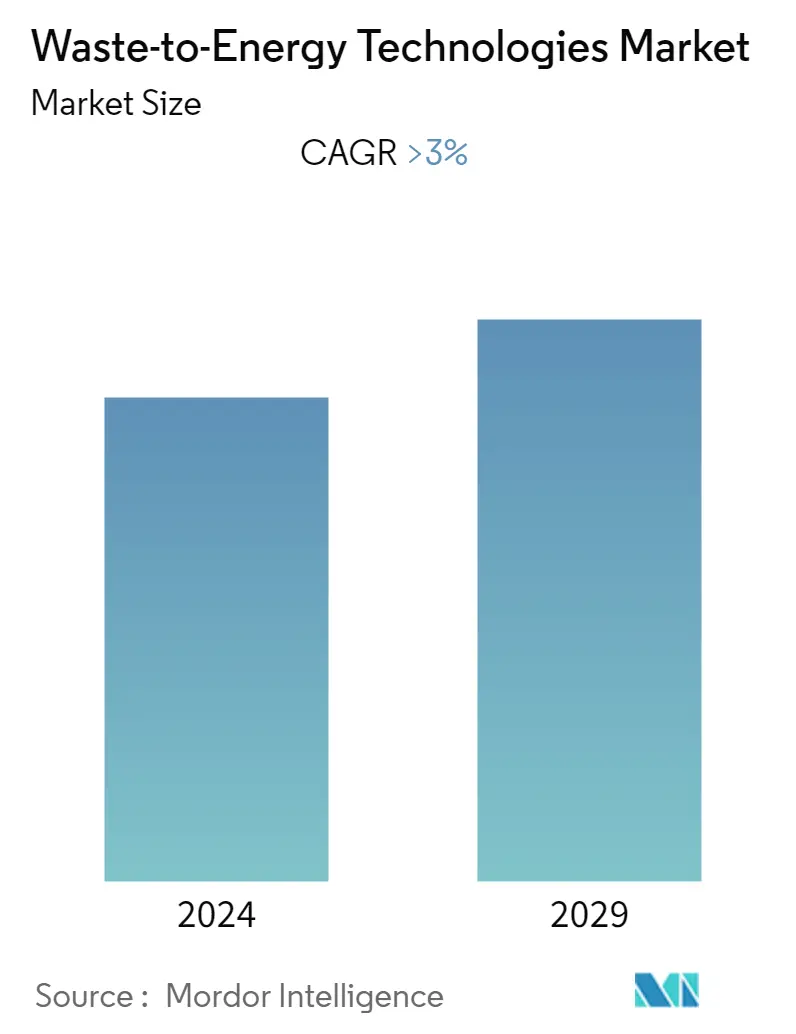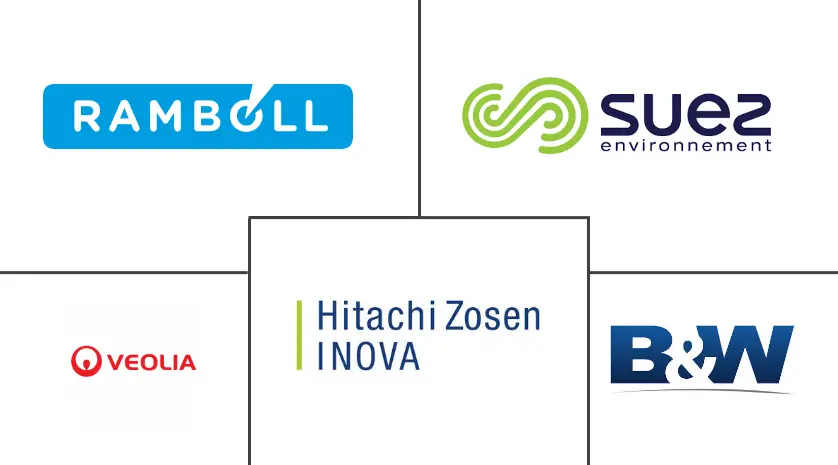Market Size of Waste-to-Energy Technologies Industry

| Study Period | 2021 - 2029 |
| Base Year For Estimation | 2023 |
| CAGR | 3.00 % |
| Fastest Growing Market | Europe |
| Largest Market | Asia Pacific |
| Market Concentration | Low |
Major Players
*Disclaimer: Major Players sorted in no particular order |
Waste-to-Energy Technologies Market Analysis
The waste-to-energy technologies market is expected to record a CAGR of more than 3% during the forecast period.
The market was negatively impacted by COVID-19. Presently, the market has reached pre-pandemic levels.
- The factors driving the market include supportive government initiatives and efforts to reduce dumps and open burning of waste in both developed and emerging economies across the world.
- However, the high capital and operation cost of waste-to-energy plants and the requirement of skilled staff to operate and maintain the sophisticated technologies may act as a restraint to the market's growth in the future.
- Waste generation is overgrowing with the increasing population. The global waste is expected to reach around 3.4 billion tons by 2050. The direct relation between population and income level is expected to increase the waste volume. Daily per capita waste generation in developed and emerging economies is also expected to increase by 40%. The need to stabilize future waste may increase the adoption of waste-to-energy technology in the future.
- Europe is one of the prominent regions to have waste-to-energy technology as it has a significant potential to reduce the region's dependency on gas imports while helping it participate in the efforts toward a carbon-neutral Europe.
Waste-to-Energy Technologies Industry Segmentation
Waste-to-energy technologies imply a set of technologies that treat municipal solid waste (MSW) to extract energy in the form of heat and electricity. This technology also helps obtain biogas as an alternate form of fuel.
The waste-to-energy technologies market is segmented by technology and geography. By technology, the market is segmented into municipal solid waste (MSW) incineration, co-processing, pyrolysis and gasification, and other technologies. By geography, the market is segmented into North America, Asia-Pacific, Europe, South America, and Middle East and Africa. The report also covers the market size and forecasts for the waste-to-energy technologies market across the major countries of the regions. For each segment, the market sizing and forecasts have been done on the revenue (USD billion).
| By Technology | |
| Municipal Solid Waste (MSW) Incineration | |
| Co-processing | |
| Pyrolysis and Gasification | |
| Other Technologies |
| By Geography | |
| North America | |
| Asia-Pacific | |
| Europe | |
| South America | |
| Middle East and Africa |
Waste-to-Energy Technologies Market Size Summary
The waste-to-energy technologies market is poised for growth, driven by supportive government initiatives and the increasing need to manage waste effectively in both developed and emerging economies. The market has rebounded to pre-pandemic levels after the negative impact of COVID-19. The rising global population and income levels are contributing to an increase in waste generation, which is expected to further boost the adoption of waste-to-energy technologies. However, the high capital and operational costs of waste-to-energy plants, along with the need for skilled personnel to manage these complex systems, pose challenges to market expansion. Europe stands out as a key region in this sector, with significant developments aimed at reducing dependency on gas imports and advancing towards carbon neutrality.
Municipal solid waste incineration (MSWI) is anticipated to be a leading technology within the waste-to-energy sector due to its ability to generate substantial electrical energy from waste. The process involves burning waste materials at high temperatures to produce flue gases, which are then used to generate electricity or heat. Despite the complexities involved in operating MSWI plants, their advantages are driving their growth. Europe, in particular, is expected to see a high compound annual growth rate (CAGR) in waste-to-energy technologies, supported by initiatives like the joint venture in Switzerland for green hydrogen production. The market is moderately fragmented, with key players such as Babcock & Wilcox Enterprises Inc., Ramboll Group AS, and Veolia leading the charge in developing and operating these technologies globally.
Waste-to-Energy Technologies Market Size - Table of Contents
-
1. MARKET OVERVIEW
-
1.1 Introduction
-
1.2 Existing Waste-to-energy Technology
-
1.3 Waste-to-Energy Technology Market in USD billion (in 2027)
-
1.4 Recent Trends and Developments
-
1.5 Government Policies and Regulations
-
1.6 Market Dynamics
-
1.6.1 Drivers
-
1.6.2 Restraints
-
-
1.7 Supply Chain Analysis
-
1.8 Porter's Five Forces Analysis
-
1.8.1 Bargaining Power of Suppliers
-
1.8.2 Bargaining Power of Consumers
-
1.8.3 Threat of New Entrants
-
1.8.4 Threat of Substitute Products and Services
-
1.8.5 Intensity of Competitive Rivalry
-
-
-
2. MARKET SEGMENTATION
-
2.1 By Technology
-
2.1.1 Municipal Solid Waste (MSW) Incineration
-
2.1.2 Co-processing
-
2.1.3 Pyrolysis and Gasification
-
2.1.4 Other Technologies
-
2.1.5
-
-
2.2 By Geography
-
2.2.1 North America
-
2.2.2 Asia-Pacific
-
2.2.3 Europe
-
2.2.4 South America
-
2.2.5 Middle East and Africa
-
-
Waste-to-Energy Technologies Market Size FAQs
What is the current Waste-to-Energy Technologies Market size?
The Waste-to-Energy Technologies Market is projected to register a CAGR of greater than 3% during the forecast period (2024-2029)
Who are the key players in Waste-to-Energy Technologies Market?
Babcock & Wilcox Enterprises, Inc, Ramboll Group , Veolia, Babcock & Wilcox Vølund A/S and Hitachi Zosen Inova AG are the major companies operating in the Waste-to-Energy Technologies Market.

